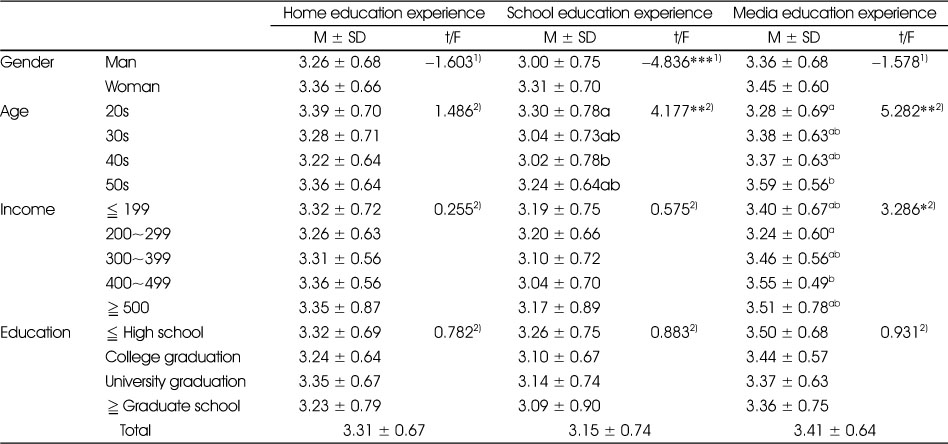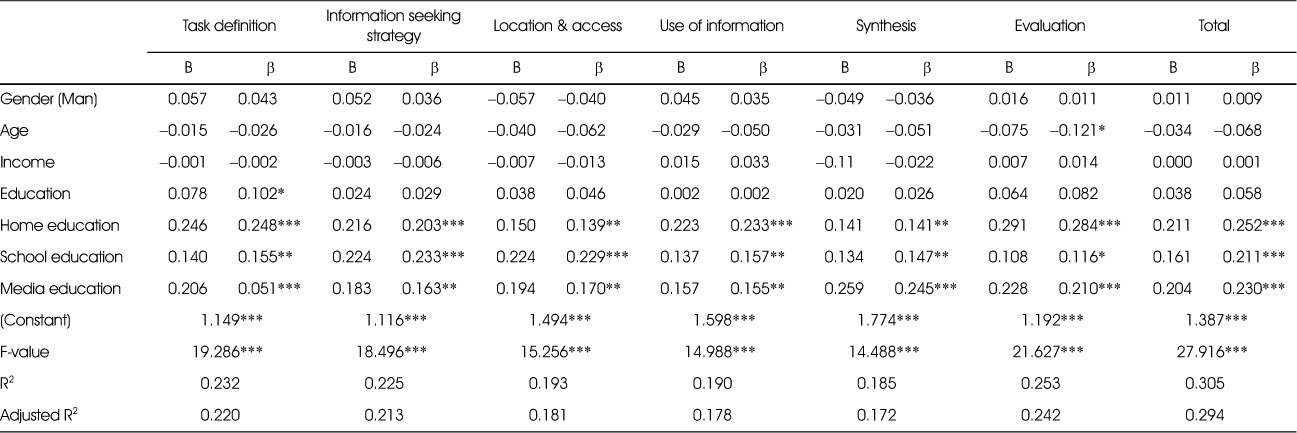Articles
- Page Path
- HOME > Korean J Community Nutr > Volume 24(5); 2019 > Article
-
Research Article
- Effect of Dietary Education Experience (Home, School, and Mass Media) on Food Consumer Information literacy
-
Ji Eun Kim
 , Kyoung Sook Choi
, Kyoung Sook Choi
-
Korean Journal of Community Nutrition 2019;24(5):363-373.
DOI: https://doi.org/10.5720/kjcn.2019.24.5.363
Published online: October 30, 2019
1Department of Home Economics Education, Dongguk University, Gyeongju, Korea, Visiting professor.
2Department of Home Economics Education, Dongguk University, Gyeongju, Korea, Instructor.
- Corresponding author: Kyoung Sook Choi. Department of Home Economics Education, Dongguk University Gyeongju Campus 123, Dongdae-ro, Gyeongju-si, Gyeongsangbuk-do, Korea. Tel: (054) 770-2527, Fax: (054) 770-2528, cks@dongguk.edu
Copyright © 2019 The Korean Society of Community Nutrition
This is an Open-Access article distributed under the terms of the Creative Commons Attribution Non-Commercial License (http://creativecommons.org/licenses/by-nc/3.0/) which permits unrestricted non-commercial use, distribution, and reproduction in any medium, provided the original work is properly cited.
- 1,116 Views
- 5 Download
- 2 Crossref
Figure & Data
REFERENCES
Citations

- Agrifood consumer competency index and food consumption behaviors based on the 2019 Consumption Behaviors Survey for Food
Eun-kyung Kim, Yong-seok Kwon, Da Eun Lee, Hee Jin Jang, Young Hee Park
Journal of Nutrition and Health.2021; 54(2): 199. CrossRef - Healthy Eating Capability of One-person Households-The Effects of Eating Alone, Meal Types, and Dietary Lifestyles
Seonglim Lee, Ilsook Choi, Junghoon Kim
Family and Environment Research.2020; 58(4): 483. CrossRef
Statement of food consumer information literacy
A 5-point Likert scale was used from 1 (strongly disagree) to 5 (strongly agree).
General characteristics of the subjects
n=454
Dietary education according to general characteristics
*: p<0.05, **: p<0.01, ***: p<0.001
A 5-point Likert scale was used from 1 (strongly disagree) to 5 (strongly agree).
1) t- value, 2) F- value
ab: Different superscripts within the same row mean differences by Duncan's post-hoc test(p<0.05).
Food consumer information literacy according to general characteristics
*: p<0.05
1) t-value, 2) F-value
Correlation relationship between dietary education and food consumer information literacy
**: p<0.01
Related variables affecting food consumer information literacy
*: p<0.05, **: p<0.01, ***: p<0.001
A 5-point Likert scale was used from 1 (strongly disagree) to 5 (strongly agree).
n=454
*: p<0.05, **: p<0.01, ***: p<0.001 A 5-point Likert scale was used from 1 (strongly disagree) to 5 (strongly agree). 1) t- value, 2) F- value ab: Different superscripts within the same row mean differences by Duncan's post-hoc test(p<0.05).
*: p<0.05 1) t-value, 2) F-value
**: p<0.01
*: p<0.05, **: p<0.01, ***: p<0.001

 KSCN
KSCN






 Cite
Cite


